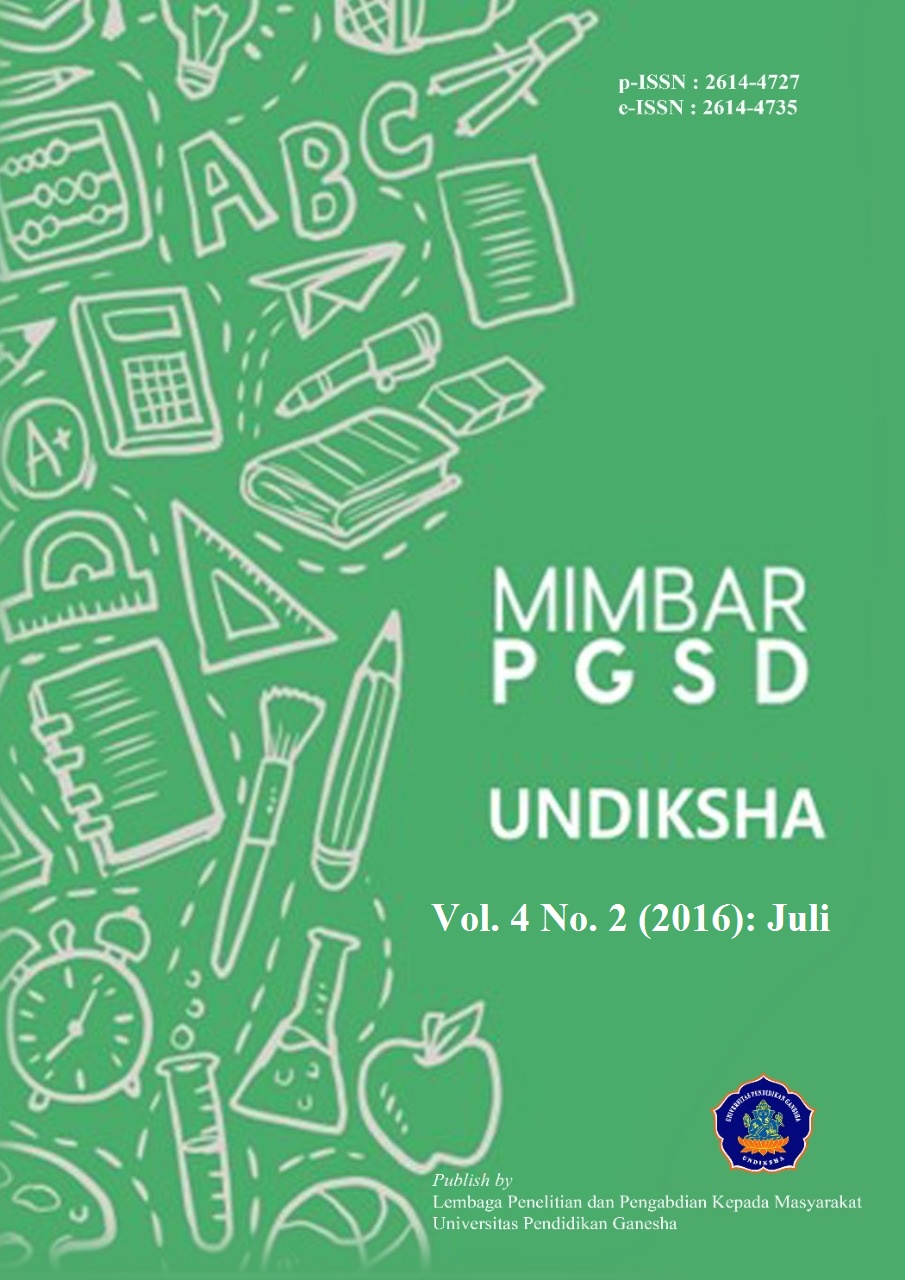ANALISIS KEMAMPUAN SISWA DALAM MENYELESAIKAN OPERASI BILANGAN BULAT PADA SISWA KELAS V SD
DOI:
https://doi.org/10.23887/jjpgsd.v4i2.7697Abstract
Penelitian deskriptif ini bertujuan untuk mendeskripsikan kemampuan siswa dalam menyelesaikan operasi bilangan bulat pada siswa kelas V di SD Negeri 2 Penarukan Kecamatan Buleleng Kabupaten Buleleng. Subjek dalam penelitian ini adalah seluruh siswa kelas V SD Negeri 2 Penarukan yang berjumlah 20 orang. Metode pengumpulan data yang digunakan dalam penelitian ini adalah observasi, tes, wawancara dan dokumentasi. Teknik analisis data dalam penelitan ini mengunakan analisis deskriptif kuantitatif dan analisis deskriptif kualitatif. Hasil penelitian memperoleh rata-rata hasil tes secara klasikal sebesar 56 dengan kategori rendah. Dari 20 jumlah siswa 5 orang siswa atau 25% memperoleh nilai di bawah rata-rata, 7 orang siswa atau 35% memperoleh nilai sama dengan rata-rata, dan 8 orang siswa atau 40% memperoleh nilai di atas rata-rata. Pada pembelajaran operasi bilangan bulat, menggunakan metode diskusi saat pembelajaran operasi perkalian dan operasi pembagian bilangan bulat. Kendala yang dihadapi siswa saat menyelesaikan operasi bilangan bulat yaitu siswa sering lupa dengan konsep operasi perkalian, pembagian dan cara penyelesaian operasi bilangan bulat. Solusi untuk mengatasi permasalahan tersebut adalah (1) memahami konsep perkalian, pembagian dan cara penyelesaian operasi bilangan bulat (2) memperbanyak latihan soal, (3) saat proses pembelajaran perlunya pengunaan media konkret untuk mengajarkan materi operasi bilangan bulat.Kata Kunci : kemampuan siswa, operasi bilangan bulat.
This descriptive research aimed to describe the student ability to complete the integer operations on grade V SD 2 Penarukan Buleleng District, Buleleng regency. Subjects in this study were all fifth grade student of SD 2 Penarukan of 20 people. Data collection methods used in this study is observation, test, interview, and documentation. Data analysis techniques in this research using descriptive analysis of quantitative and qualitative descriptive analysis. The results of the study earned an average of classical test results for 56 with low category. Of the 20 student enrolled 5 students or 25% received grades below average, 7 student or 35% gain value is equal to the average, and 8 people or 40% of student scoring above average. On learning integer operations, using the method of discussion during the learning multiplication and integer division operation. The obstacles faced by student while completing integer operations that students often forget the concept of multiplication, division and settlement integer operations. The solution to overcome these problems are (1) understanding the concept of multiplication, division and settlement integer operations (2) reproduce exercises, (3) when the process study the need to use the media to teach the material concrete integer operations.
keyword : the ability of students, integer operations.
Published
2016-07-20
How to Cite
., I. K. P. A., ., D. I. M. S. M., & ., D. I. N. M. (2016). ANALISIS KEMAMPUAN SISWA DALAM MENYELESAIKAN OPERASI BILANGAN BULAT PADA SISWA KELAS V SD . MIMBAR PGSD Undiksha, 4(2). https://doi.org/10.23887/jjpgsd.v4i2.7697
Issue
Section
Articles
License
Authors who publish with the Mimbar PGSD Undiksha agree to the following terms:
- Authors retain copyright and grant the journal the right of first publication with the work simultaneously licensed under a Creative Commons Attribution License (CC BY-SA 4.0) that allows others to share the work with an acknowledgment of the work's authorship and initial publication in this journal.
- Authors are able to enter into separate, additional contractual arrangements for the non-exclusive distribution of the journal's published version of the work (e.g., post it to an institutional repository or publish it in a book), with an acknowledgment of its initial publication in this journal.
- Authors are permitted and encouraged to post their work online (e.g., in institutional repositories or on their website) prior to and during the submission process, as it can lead to productive exchanges, as well as earlier and greater citation of published work. (See The Effect of Open Access)















